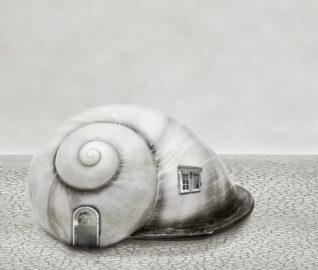
What are your earliest memories of home? I remember a black and white tiled hallway in the house I moved away from at the age of three. I recall my great aunt’s ancient abode smelling of folded up paper bags and mothballs, the lone room at the top of the stairs and the mysterious pyramid stored there, made of wood but covered with putty into which my great grandmother had stuck mementos from her dead child’s youth.
Domestic spaces have practical value. They also have spiritual and archetypal qualities “connecting us, in our everyday lives, as we sleep and wake and cook and clean, to the realm of the gods, the fairies, the ancestors, and to worlds of magic.”
The yearning for home seems built into our DNA. Some liken it to our fall from grace; many have written about it, (most famously–from 8th century BC–Homer’s The Odyssey). On a humbler note, Kenneth Grahame’s masterwork The Wind in the Willows, an episodic fairy tale, if you will, takes the tiny creature Mole on a series of adventures. One day, when the breath of winter is upon him, Mole feels the instinctual pull of his comfy hole in the ground.
We others, who have long lost the more subtle of the physical senses, have not even proper terms to express an animal’s intercommunications with his surroundings, living or otherwise, and have only the word ‘smell’, for instance, to include the whole range of delicate thrills which murmur in the nose of the animal night and day, summoning, warning, inciting, repelling. It was one of these mysterious fairy calls from out of the void that suddenly reached Mole in the darkness, making him tingle through and through with its very familiar appeal, even while as yet he could not clearly remember what it was. He stopped dead in his tracks, his nose searching hither and thither in its efforts to recapture the fine filament, the telegraphic current, that had so strongly moved him. A moment, and he had caught it again; and with it this time came recollection in fullest flood.
Home!
Kenneth Grahame, The Wind in the Willows
In fairy tales, home, whether present or absent, sanctuary or otherwise, is a force to be reckoned with. It’s during Mole’s wandering that home beckons loudest. And while Cinderella is never technically homeless, the interruption of domestic peace by the arrival of her step-family leaves her yearning for connection in a way that those of us who have felt not quite at home while at home can understand.
It’s a dangerous business, Frodo, going out your door. You step onto the road, and if you don’t keep your feet, there’s no knowing where you might be swept off to.
J.R.R. Tolkien, The Fellowship of the Ring
It’s often the tension between the call to adventure and the yearning for home that drives the engine of story. Hansel and Gretel are attracted to the delectable home of a dangerous witch. Bilbo never wanted to leave Bag End in the first place, but after his grand adventure, he is restless for more. Frodo’s grim realization that he can never really return home propels him westward.
Home is protection. It is also perseverance. It takes time, energy, and commitment to create and sustain a home. This is true whether home is a structure or an intangible vault of hard won self-knowledge and care. Home can look like a castle or a backpack. It can also be your own skin.

In her gorgeous retelling of the selkie legend, “Sealskin, Soulskin,” Clarissa Pinkola Estes writes of a man so lonely he is at home nowhere, not even in his own skin. When he spies a beautiful woman dancing in the moonlight on top of a great rock poking up from the sea, he finds and takes her sealskin, binding her to him, as he claims, for seven years.
They live together and have a son. When seven years pass, the man breaks his promise; they fight and he storms out in a rage. The son loves his mother, and though he doesn’t want to lose her, he is drawn to the sea and the skin that is hidden in a secret place on the shore. He does what his father would not, restoring his mother’s sealskin. With renewed vigor, the selkie returns to the sea. The legacy for all three of them is heartbreak. The man is lonelier than ever. The selkie has left a piece of her heart behind. The son will never feel entirely at home anywhere.
Every creature on earth returns to home. It is ironic that we have made wildlife refuges for ibis, pelican, egret, wolf, crane, deer, mouse, moose, and bear, but not for ourselves in the places where we live day after day. We understand that the loss of habitat is the most disastrous event that can occur to a free creature. We fervently point out how other creatures’ natural territories have become surrounded by cities, ranches, highways, noise, and other dissonance, as though we are not surrounded by the same, as though we are not affected also. We know that for creatures to live on, they must at least from time to time have a home place, a place where they feel both protected and free.
Clarissa Pinkola Estes, Women Who Run With the Wolves
We do not often conflate protection and freedom. Skin and soul. It is when we have both that we are at home.
(Cross-posted at Luna Station Quarterly)
First Image Credit: Catharina77 at Pixabay.com
Second Image Credit: marcelkessler at Pixabay.com
